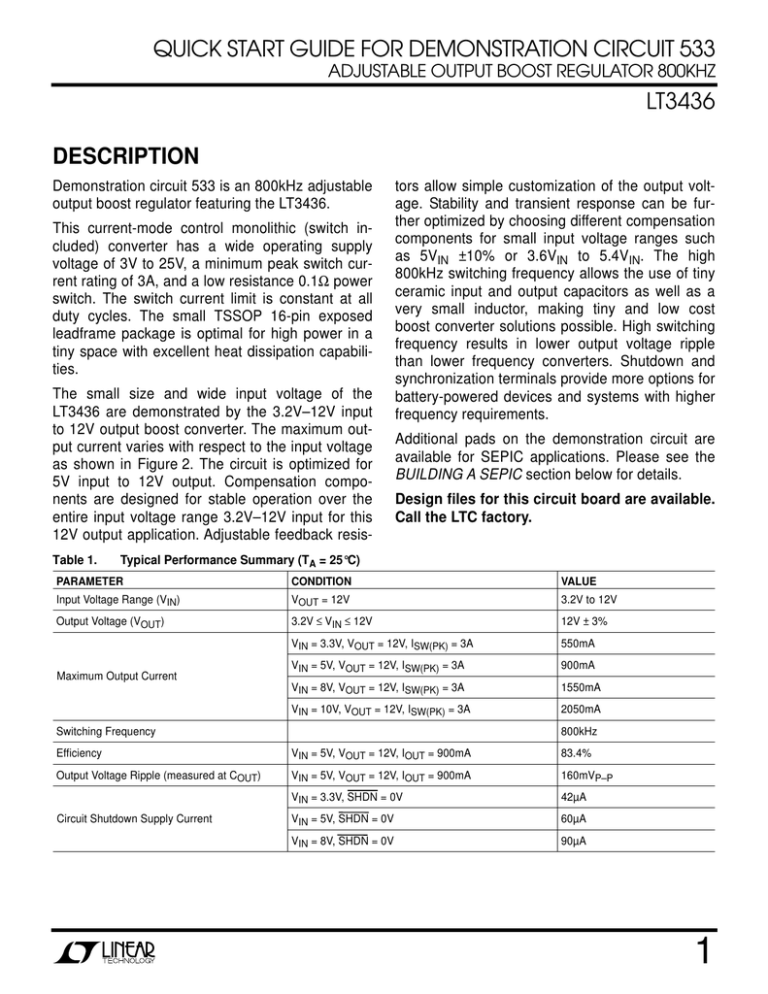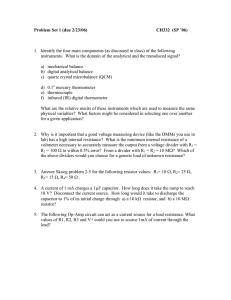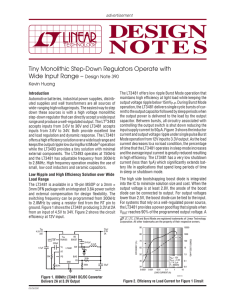DC533 - LT3436EFE Evaluation Kit Quick Start Guide
advertisement

QUICK START GUIDE FOR DEMONSTRATION CIRCUIT 533 ADJUSTABLE OUTPUT BOOST REGULATOR 800KHZ LT3436 DESCRIPTION Demonstration circuit 533 is an 800kHz adjustable output boost regulator featuring the LT3436. This current-mode control monolithic (switch included) converter has a wide operating supply voltage of 3V to 25V, a minimum peak switch current rating of 3A, and a low resistance 0.1Ω power switch. The switch current limit is constant at all duty cycles. The small TSSOP 16-pin exposed leadframe package is optimal for high power in a tiny space with excellent heat dissipation capabilities. The small size and wide input voltage of the LT3436 are demonstrated by the 3.2V–12V input to 12V output boost converter. The maximum output current varies with respect to the input voltage as shown in Figure 2. The circuit is optimized for 5V input to 12V output. Compensation components are designed for stable operation over the entire input voltage range 3.2V–12V input for this 12V output application. Adjustable feedback resisTable 1. tors allow simple customization of the output voltage. Stability and transient response can be further optimized by choosing different compensation components for small input voltage ranges such as 5VIN ±10% or 3.6VIN to 5.4VIN. The high 800kHz switching frequency allows the use of tiny ceramic input and output capacitors as well as a very small inductor, making tiny and low cost boost converter solutions possible. High switching frequency results in lower output voltage ripple than lower frequency converters. Shutdown and synchronization terminals provide more options for battery-powered devices and systems with higher frequency requirements. Additional pads on the demonstration circuit are available for SEPIC applications. Please see the BUILDING A SEPIC section below for details. Design files for this circuit board are available. Call the LTC factory. Typical Performance Summary (TA = 25°C) PARAMETER CONDITION VALUE Input Voltage Range (VIN) VOUT = 12V 3.2V to 12V Output Voltage (VOUT) 3.2V ≤ VIN ≤ 12V 12V ± 3% VIN = 3.3V, VOUT = 12V, ISW(PK) = 3A 550mA VIN = 5V, VOUT = 12V, ISW(PK) = 3A 900mA VIN = 8V, VOUT = 12V, ISW(PK) = 3A 1550mA VIN = 10V, VOUT = 12V, ISW(PK) = 3A 2050mA Maximum Output Current Switching Frequency 800kHz Efficiency VIN = 5V, VOUT = 12V, IOUT = 900mA 83.4% Output Voltage Ripple (measured at COUT) VIN = 5V, VOUT = 12V, IOUT = 900mA 160mVP–P VIN = 3.3V, SHDN = 0V 42µA VIN = 5V, SHDN = 0V 60µA VIN = 8V, SHDN = 0V 90µA Circuit Shutdown Supply Current 1 QUICK START GUIDE FOR DEMONSTRATION CIRCUIT 533 ADJUSTABLE OUTPUT BOOST REGULATOR 800KHZ QUICK START PROCEDURE Demonstration circuit 533 is easy to set up to evaluate the performance of the LT3436. Refer to Figure 1 for proper measurement equipment setup and follow the procedure below: NOTE: Make sure that the input voltage does not exceed 12V. NOTE: The synchronization and shutdown functions are optional and their pins can be left floating (disconnected) if their functions are not being used. NOTE: Connect the power supply (with power off), load, and meters as shown in Figure 1. 1. After all connections are made, turn on input power and verify that the output voltage is 12V. NOTE: If the output voltage is too low, temporarily disconnect the load to make sure that the load is not set too high. 2. Once the proper output voltage is established, adjust the load within the operating range and observe the output voltage regulation, ripple voltage, efficiency and other parameters. Figure 1. Proper Measurement Equipment Setup FUNCTIONS & OPTIONS OUTPUT VOLTAGE The components assembled on the board are optimized for a wide input voltage range and a 12V output. The feedback resistors (R1, R2) can be 2 QUICK START GUIDE FOR DEMONSTRATION CIRCUIT 533 ADJUSTABLE OUTPUT BOOST REGULATOR 800KHZ changed to adjust the output voltage according to the following equation: VOUT = 1.2 × (1 + R1/R2) SHUTDOWN AND UNDERVOLTAGE LOCKOUT The SHDN pin is directly connected to its terminal and left floating for normal operation. However, connecting the terminal to GND will place the IC in shutdown. In shutdown, the IC will typically only consume 6µA, but the output voltage will not drop to zero volts. Its voltage will remain approximately equal to the input voltage and will continue to provide power to whatever load is present through the direct path of the inductor and catch diode from VIN. For undervoltage lockout, the two-resistor divider network must be placed between VIN and SHDN and between SHDN and GND. Please see the data sheet section ‘Shutdown Functions and Undervoltage Lockout’ for more details on resistor values and application examples. SYNCHRONIZATION The synchronization frequency range for the LT3436 is 960kHz to 1.4MHz. Use a logic level sync signal with a duty cycle between 10% and 90% connected directly to the SYNC terminal. Keep in mind that synchronization at high frequencies may reduce the effect of slope compensation. High sync frequencies combined with high duty cycles (above 50%) may result in unexpected loop instability. An increase in inductance or new compensation values may help overcome this instability at high frequencies. COMPENSATION DC533 has a frequency compensation network that is optimized for the ceramic output capacitor C2, the wide input voltage range of 3.2V to 12V, and 12V output. Improved loop bandwidth can be achieved for various output voltages, output capacitors, and input voltage ranges by adjusting R3, C3 and C4. A feedforward capacitor (C5) can be placed in parallel with R1 in the location shown in Figure 15 for an extra zero in the control loop. The use of alternate output capacitors may require changes to the compensation components for optimized loop stability. For more information, see the ‘Frequency Compensation’ section in the datasheet, Application Note 19, or Application Note 76. 3 QUICK START GUIDE FOR DEMONSTRATION CIRCUIT 533 ADJUSTABLE OUTPUT BOOST REGULATOR 800KHZ MAXIMUM LOAD CURRENT (A) 2.25 2.00 1.75 1.50 1.25 1.00 0.75 0.50 0.25 0.00 0 1 2 3 4 5 6 7 8 9 10 11 12 INPUT VOLTAGE (V) Figure 2. Maximum load current increases with input voltage 100% 10VIN 90% EFFICIENCY (%) 80% 5VIN 70% 3.3VIN 60% 50% 40% 30% 20% 10% 2.25 2.00 1.50 1.75 1.00 1.25 0.50 0.75 0.00 0.25 0% LOAD CURRENT (mA) Figure 3. Efficiency versus load current 4 QUICK START GUIDE FOR DEMONSTRATION CIRCUIT 533 ADJUSTABLE OUTPUT BOOST REGULATOR 800KHZ Figure 4. Output Voltage Ripple (IOUT = 550mA, VIN = 3.3V, VOUT = 12V, TA = 25°C) CH1 is VOUT ripple (AC), CH2 is VSW Figure 5. Output Voltage Ripple (IOUT = 900mA, VIN = 5V, VOUT = 12V, TA = 25°C) CH2 is VOUT ripple (AC), CH3 is VSW 5 QUICK START GUIDE FOR DEMONSTRATION CIRCUIT 533 ADJUSTABLE OUTPUT BOOST REGULATOR 800KHZ Figure 6. DC533 Step Load Response (IOUT = 250mA to 500mA, VIN = 3.5V, TA = 25°C, VOUT = Ω) 12V) CH2 is VOUT ripple (AC), CH4 is IOUT (200mA/10mVΩ Figure 7. DC533 Step Load Response (IOUT = 400mA to 800mA, VIN = 5V, TA = 25°C, VOUT = 12V) CH2 is VOUT ripple (AC), CH4 is IOUT (500mA/10mVΩ Ω) 6 QUICK START GUIDE FOR DEMONSTRATION CIRCUIT 533 ADJUSTABLE OUTPUT BOOST REGULATOR 800KHZ Figure 8. DC533 Step Load Response (IOUT = 400mA to 800mA, VIN = 8V, TA = 25°C, VOUT = Ω) 12V) CH1 is VOUT ripple (AC), CH2 is IOUT (500mA/10mVΩ 3.3VIN 12VOUT 550mAOUT 60 CASE TEMPERATURE (°C) 50 40 30 20 10 0 0 1 2 3 4 5 TIME (minutes) Figure 9. Five Minute Thermal Profile of DC533× ×4 (IOUT = 550mA, VIN = 3.3V, TA = 25°C, VOUT = 12V) 7 QUICK START GUIDE FOR DEMONSTRATION CIRCUIT 533 ADJUSTABLE OUTPUT BOOST REGULATOR 800KHZ 5VIN 12VOUT 900mAOUT 60 CASE TEMPERATURE (°C) 50 40 30 20 10 0 0 1 2 3 4 5 TIME (minutes) Figure 10. Five Minute Thermal Profile of DC533× ×4 (IOUT = 900mA, VIN = 5V, TA = 25°C, VOUT = 12V) 8VIN 12VOUT 1550mAOUT 60 CASE TEMPERATURE (°C) 50 40 30 20 10 0 0 1 2 3 4 5 TIME (minutes) Figure 11. Five Minute Thermal Profile of DC533× ×4 (IOUT = 1550mA, VIN = 8V, TA = 25°C, VOUT = 12V) 8 QUICK START GUIDE FOR DEMONSTRATION CIRCUIT 533 ADJUSTABLE OUTPUT BOOST REGULATOR 800KHZ Figure 12. DC533 Bode Plot (IOUT = 900mA, VIN = 5V, TA = 25°C, VOUT = 12V) Figure 13. DC533 Bode Plot (IOUT = 1550mA, VIN = 8V, TA = 25°C, VOUT = 12V) 9 QUICK START GUIDE FOR DEMONSTRATION CIRCUIT 533 ADJUSTABLE OUTPUT BOOST REGULATOR 800KHZ Figure 14. DC533 Bode Plot (IOUT = 550mA, VIN = 3.3V, TA = 25°C, VOUT = 12V) BUILDING A SEPIC The DC533 can be easily modified to create a SEPIC (Single-Ended Primary Inductance Converter). Figure 15 shows a 3V to 20V input 5V output SEPIC converter. The maximum load current increases with input voltage and is shown in Figure 16. The SEPIC converter can be built with either a transformer or two separate inductors since the energy passed between the primary and secondary follows the path through the coupling capacitor (C7) instead of the core of the transformer. Figure 18 and Figure 19 show the component placement for the SEPIC on the DC533. The feedback resistors and the compensation resistor and capacitor are different in the 5VOUT SEPIC than in the 12VOUT boost. The component location changes from the typical boost circuit are the following: L2 (or T1) is added to the circuit C7 is placed where D1 used to be C2 is moved to the new location A cut is made to separate the pads of D1 D1 is placed in a new location Feedback path on back is altered (Figure 20) The new location of D1 places both pads of D1 on the same electrical node (VOUT in the boost circuit). An Exacto knife cut must be made to separate the two pads electrically before it is placed in the circuit for the SEPIC. There is already a cut two thirds of the way across the VOUT node. This cut reduces output voltage ripple that is seen at the terminals in the boost configuration. Extend this cut all the way across the node through D1 and then place D1 in its new location as shown in Figure 18. The path from VOUT to the feedback resistors is on the backside of the board. In the boost application, the feedback via is located at the top of C2. When C2 is moved to a new location for the SEPIC, the feedback path must also move. The backside of the board must be slightly altered to source the output voltage measurement from its new location and still monitor feedback from VOUT. Figure 20 shows how the old feedback via must be cut from 10 QUICK START GUIDE FOR DEMONSTRATION CIRCUIT 533 ADJUSTABLE OUTPUT BOOST REGULATOR 800KHZ anode of D1 (the location of the feedback via for the boost that should have been removed from the path.) the feedback path and the new feedback via must be added to the feedback path. Make sure that there is no longer a short between VOUT and the OPTION: Replace L1, L2 with transformer CTX5-1A, CTX8-1A, CTX10-2A VIN +3V TO 20V L1 C7 CDRH6D28-100 D1 VOUT +5V E1 E2 C1 U1 LT3436EFE + OPT B220A 1.0uF, 25V, X5R Ceramic L2 CDRH6D28-100 Vin SW C6 C5 OPT R1 31.6k 1% 0603 OPT SHDN E5 /shdn FB E4 SYNC SYNC GND C3 GND C1 4.7uF X5R 25V Ceramic Vc 10nF 0603 C4 470pF 0603 R3 2.2k 5% 0603 R2 10.0k 1% 0603 GND C2 22uF X5R 10V Ceramic GND E3 E6 Figure 15. LT3436 3V to 20VIN 5VOUT SEPIC with either two inductors or a transformer 11 QUICK START GUIDE FOR DEMONSTRATION CIRCUIT 533 ADJUSTABLE OUTPUT BOOST REGULATOR 800KHZ MAXIMUM LOAD CURRENT (mA) 2.0 1.8 1.6 1.4 1.2 1.0 0.8 0.6 0.4 0.2 0.0 0 2 4 6 8 10 12 14 16 18 20 VIN (V) Figure 16. Maximum load current of the SEPIC in Figure 15 increases with input voltage 100% 90% 12VIN EFFICIENCY (%) 80% 70% 3.3VIN 60% 5VIN 50% 40% 30% 20% 10% 0% 0 500 1.0k 1.5k 2.0k LOAD CURRENT (mA) Figure 17. Efficiency of SEPIC in Figure 15 12 QUICK START GUIDE FOR DEMONSTRATION CIRCUIT 533 ADJUSTABLE OUTPUT BOOST REGULATOR 800KHZ Figure 18. DC533A SEPIC customization topside component placement with two inductors 13 QUICK START GUIDE FOR DEMONSTRATION CIRCUIT 533 ADJUSTABLE OUTPUT BOOST REGULATOR 800KHZ Figure 19. DC533A SEPIC customization topside component placement with transformer 14 QUICK START GUIDE FOR DEMONSTRATION CIRCUIT 533 ADJUSTABLE OUTPUT BOOST REGULATOR 800KHZ Figure 20. DC533A SEPIC customization backside feedback path alteration 15 QUICK START GUIDE FOR DEMONSTRATION CIRCUIT 533 ADJUSTABLE OUTPUT BOOST REGULATOR 800KHZ 16 5 4 3 2 1 D D VIN SW SW 3 4 11 SHDN FB 12 14 SYNC VC 13 NC NC NC 15 10 7 2 C 1 5 6 8 9 16 GND GND GND GND GND GND C B B A A 5 4 3 2 1 Item Qty Reference 1 2 3 4 5 6 7 8 9 10 11 12 13 14 15 16 1 1 1 1 0 0 0 1 1 1 1 1 6 1 1 1 C1 C2 C3 C4 C5 (OPT) C6 (OPT) C7 (OPT) D1 L1 R1 R2 R3 TP1-TP6 U1 Part Description Cap., X7R 4.7uF 16V 20% Cap., X5R 22uF 16V 20% Cap., X7R 0.01uF 25V 5% Cap., NPO 470pF 25V 5% OPTIONAL OPTIONAL OPTIONAL Schottky Barrier 20V/2A Inductor, 4.7uH Res., Chip 90.9K 0.06W 1% Res., Chip 10K 0.06W 1% Res., Chip 4.7K 0.06W 5% Turret, Testpoint I.C., Boost Volt. Reg. PRINTED CIRCUIT BOARD STENCIL Manufacture / Part # TDK C3216X7R1C475M TDK C3225X5R1C226M AVX 06033C103KAT2A AVX 06033A471JAT1A Diodes Inc. B220A-13 Sumida CDRH8D28-4R7NC AAC CR16-9092FM AAC CR16-1002FM AAC CR16-472JM Mill Max 2501-2 Linear Tech. Corp. LT3436EFE DEMO CIRCUIT #533A STENCIL




